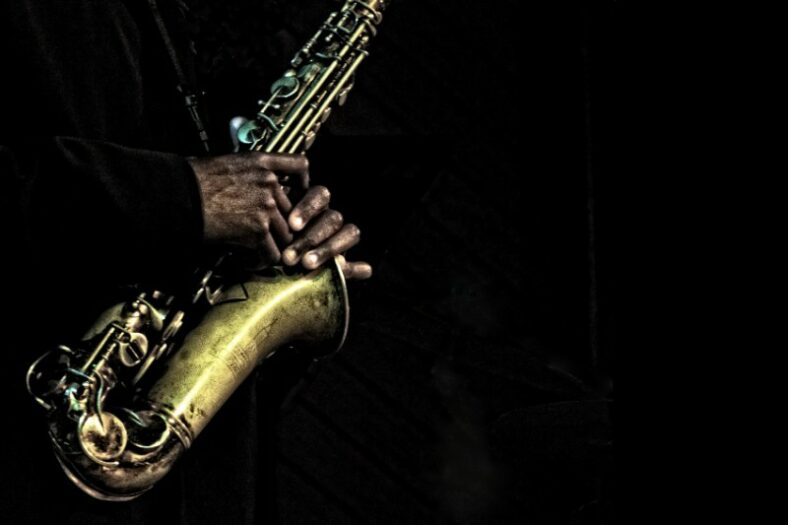The History Of Blues Music

Blues music originated in the south of the United States during the late 19th century. It started as the music of enslaved Africans and Black Americans before entering the mainstream scene in the country. The music comes from the oral tradition of Afro-American work songs and spirituals.
Blues is characterized by melancholy subjects, melodies, and sounds. It features the call-and-response singing style derived from Afro-American traditions, specific chord progressions, AAB lyric patterns, and dissonant harmonies. But, Blues evolved a lot through the years, with artists creating new subgenres and their own styles that pushed the limits of the genre’s definition.
Contents
Characteristics of Blues Music
Just like any music genre, blues music has defining elements that give it the unique sound it has. Here are some of them:
Call and Response: Blues music has call-and-response style progressions derived from Afro-American culture. It means one instrument or voice responds to the other, making a kind of dialogue in the song.
Specific Chord Progressions: Mainly, blues music uses the I, IV, and V chord progression in a given scale. So, let’s say there is a song in the key of D. The progression will be D, G, and A chords, the first, the fourth, and the fifth notes of the D scale.
Flattened Blues Notes: A crucial characteristic of blues music is the flattened blues notes. These notes blur the feelings of minor and major scales, and they are often the scale’s seventh, fifth, and third notes. These flattened notes give the characteristics of the so-called Blues scale.
Syncopation: Syncopation is very important when playing blues as it mixes phrases with different note durations. This way, the music gets more interesting and less monotonous and gives a unique vibe to the genre.
12-bar – 48-beat Patterns: While there are now different blues songs with different rhythmic patterns, Blues music is mainly characterized by the 12-bar and 48-beat patterns. A 12-bar blues has three four-bar patterns, the standard blues progression.
Melisma: Melisma is a singing style that means singing a single syllable over a series of different notes. It creates great drama in the song, giving the genre a characteristic sound.
Instruments: Blues music often features electric or acoustic guitars, a drum kit, bass, pianos, or organs, as well as saxophone, harmonica, and blues harp occasionally.
Who was the Father of the Blues?
There is no clear answer to the question of who was the father of the Blues. But, one name stands out from the crowd – W.C. Handy, as he was the first artist to write down the blues. With his songs, like “Dallas Blues” and “Memphis Blues” in 1912, he created the famous 12-bar structure.
But, W.C. Handy was not the inventor of the Blues, as many names significantly contributed to the genre, such as Charley Patton, Robert Johnson, Muddy Waters, and Lead Belly. So, it is not easy to choose a “Father of the Blues,” as it seems the genre has many fathers, and it was their collective contributions that created the unique structure, sound, and feel of the Blues.
What was the first Blues song?
The first Blues songs ever written down were the “Memphis Blues” and “Dallas Blues” in 1912 by William Christopher Handy. While there were Blues songs before performed, these are considered the first Blues songs as they were the first ones to be recorded.
History of Blues Music
Blues music’s history started in the late 19th century in the southern United States with enslaved African-Americans and Black Americans. They brought their African musical traditions, mixing them with western music to create the genre we know as Blues.
The Birth Of The Blues (Late 19th Century)
The blues music roots go to the Mississippi Delta near New Orleans, where jazz was also born. When African enslaved people were taken to the North American colonies, they came with their traditions, culture, and music. With the end of the Civil War, African-American people did not have many choices but to do extremely hard work in poor conditions that required high stamina.
They sang work songs while working in the plantations and religious spirituals and hymns in the church. The hard lives they were destined to live were reflected in their daily lives and culture, which affected the songs they were singing. The music had soulful and melancholy lyrics of the poor lives but with powerful, passionate, and rhythmic characteristics, which also celebrated the lives of their community.
These were the first steps of Blues music as work songs were sung rhythmically in sync with the work done. The enslaved people combined the songs with African rhythms and used call-and-response-style singing while working or in the church. So, the music of the white European settlers started to mix up with the African music and rhythms the slaves brought, which was the recipe for a new genre called the Blues.
The first example of the blues style music features a solo singer with a guitar or piano accompaniment and drums as the rhythmic background. Sometimes the music also had a harmonica. The earliest blues was known as the country blues. Bf Robert Johnson and Lead Belly were the first famous names in the country blues.
Early Blues (Early 20th Century)
After the first baby steps of the genre among the Afro-American community, the genre became more widespread in the early 20th century. White audiences also started to get interested in the Blues, which became very popular in the 1920s.
During this time first Blues songs were recorded by William Christopher Handy, the songs “Memphis Blues” and “Dallas Blues” in 1912. As the first copyrighted Blues songs, they were the legacy of enslaved Black Americans. The genre was called the Country Blues or the Delta Blues, as it came from Delta, Mississippi.
The Delta Blues perfectly reflected the hard lives, struggles, and harsh conditions the African-Americans were living. There were already many traditional songs sung by the workers, which were transformed and adapted to new ones in the early 20th century.
The Delta Blues feature strong vocals, simple but powerful and melancholic lyrics, slide guitar riffs, rhythmic background, and harmonica solos and embellishments. Artists like Robert Johnson, Bessie Smith, and William Christopher Handy made the genre quite popular during the 1920s and were country music’s first stars.
Around 1915, many African-Americans started leaving the south because of poor economic conditions, oppression, and struggles in everyday life. They mainly settled around Chicago and Detroit and brought the Blues with them. There, the Blues would meet with new instruments, sounds, and playing styles.
Modern Blues (Mid-20th Century and Later)
When the Blues arrived in the North, it met with different instruments, playing styles, and rhythms, transforming the genre into a more electric and urban style. New blues genres were born, collectively called the City Blues or Urban Blues.
City Blues became a highly popular genre not only in black bars and clubs but also among the white audience during the 1950s. Different blues subgenres were born with the influence of jazz. Some popular City Blues artists were B.B. King, Elmore James, T-Bone Walker, and Howlin’ Wolf.
Blues was transforming rapidly during that time, becoming the mother of many popular genres that would dominate the world for the next 50 years. The Blues guitarists T-Bone Walker’s playing style, sound, and techniques were signaling the birth of rock n’ roll and rock music.
With his long guitar solos and way of cranking up his amp to overdrive and distortion levels, he pioneered the rock guitar sound and style. With the contribution of other guitarists like B.B. King and Buddy Guy, new artists and genres were coming to the scene with the inspiration from Blues music.
In the 1960s, the Blues was already within international borders as it had a big audience in the U.K. and Western Europe. Guitarists like Stan Webb and Eric Clapton were the first artists of blues rock style music. Blues, at that time, was officially the driving force behind rock n’ roll and rock music.
Chuck Berry and Bo Diddley combined the Blues’ origins with a more enthusiastic playing style, which became rock n’ roll. They removed the melancholy aspect of blues and made it more uplifting with a higher tempo.
While rock and rock n’ roll were starting their own journey with the inspiration from the Blues, the Blues music itself was also going its own way. There were many different Blues subgenres already, as the music was moving to different regions and affected by different regional characteristics. Some examples are the Chicago Blues, the Memphis Blues, and the New Orleans Blues.
Today, many different Blues styles push the limits and definition of Blues music. For example, melancholy and sad music and lyrics are no longer necessary for Blues music. Many artists take the Blues structure and play with it on their terms to create unique Blues pieces.
Main Blues Genres
While there are many different Blues subgenres today, there are 8 subgenres that can be considered the main ones.
Boogie-Woogie Blues
Boogie-Woogie Blues is the Blues subgenre with a piano-based style. It was highly popular during World War I years and later. Some important artists of the genre were Pinetop Perkins and Big Joe Turner.
Blues Rock
Blues Rock became highly popular as the getaway genre from the Blues to Rock and rock n’ roll. It was inspired by the playing style, sound, and techniques of Urban Blues guitarists such as T-Bone Walker and B.B. King.
Blues Rock has a heavier sound than Blues and is characterized by cranked-up amps and a more aggressive playing style with a higher tempo. Stan Webb and Eric Clapton were some of the genre’s first and most popular artists.
Delta Blues
Delta Blues is one of the first genres of Blues music. The first ever recorded songs of the Blues were Delta Blues songs, “Memphis Blues,” and “Dallas Blues” by W.C. Handy in 1912. The genre was born in Mississippi and had dominant guitar and harmonica in the melodies. James Cotton, W.C. Handy, and Sonny Boy Williamson are some of the most important names of the genre.
Chicago Blues
Chicago Blues was created in the mid-20th century when the Afro-Americans traveled from the South to the North to find better living conditions. They were settled around Chicago, transforming the Blues into a more electric and urban style with high-energy guitars and more amplification. Muddy Waters, Magic Sam, and Otis Rush were the genre pioneers.
Jump Blues
Jump Blues dates back to the 1940s and is characterized by its up-tempo rowdy vocals, swing style, and saxophone riffs, borrowed from jazz music. Cab Calloway and Sam Taylor are the first names to come to mind when talking about Jump Blues.
Soul Blues
Soul Blues came to the music scene during the 60s and 70s and is the mother of R&B. It features a combination of modern urban and soul music with traditional blues elements. Ray Charles is the legend of the genre.
Texas Blues
With repetitive riffs and a hard swing style, Texas Blues is characterized by the country elements in the music, slide guitar, different blues and jazz melodies, and a lot of twangs. Stevie Ray Vaughn is the main name of the genre, among the great guitarist T-Bone Walker.
New Orleans Blues
New Orleans Blues feature Latin influences with Cajon as the percussion, rumba as the rhythmic aspect, and a jazz swing that gets you going. James Booker, Fats Domino, and Guitar Slim are the first names to mention in New Orleans Blues.
Blues Lyrics
As Blues was born from the struggles of the Afro-American community and their struggles when they first arrived in North America, the lyrics typically feature harsh topics, melancholy, and sadness. That is why “feeling the Blues” means feeling sad and gloomy.
The initial lyrics of the genre were about the struggles of Afro-Americans, drinking, jail, murder, hard labor, poverty, and lost love. Blues songs are often lyrical and poetic rather than narrative. Blues artists express their feelings of sadness and melancholy while touching on the topics which made them feel that way. The oppression and hard times the Black Americans lived through played a huge role in the music and lyrics.
But, later, many Blues artists started producing songs with a wider lyrics frame. The sadness and melancholy are still felt in the melodies, but it is no longer necessary for the lyrics to be “bluesy.”
Conclusion
Blues is one of the most important genres, influencing almost every popular music genre, from hip-hop to metal. The long history behind it, the simplicity of the 12-bar structure, and the melancholy and sadness of the melodies and lyrics made the genre popular. It gave artists a chance to express their feelings freely. And that is why the Blues played a key role in music history.





